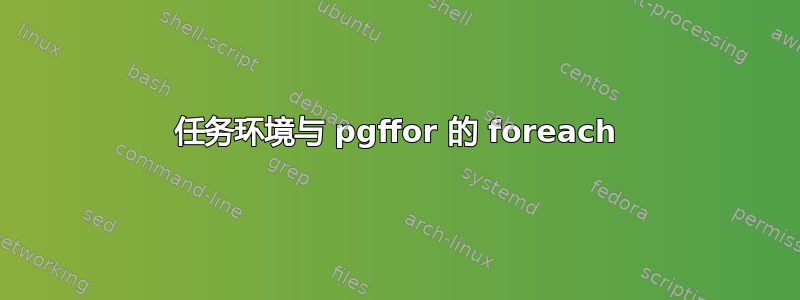
我想\foreach在列表中创建任务(通过包tasks) 放在问题中。MWE:
\documentclass{article}
\usepackage[magyar]{babel}
\usepackage[utf8x]{inputenc}
\usepackage{t1enc}
\usepackage{exsheets}
\usepackage{pgffor}
\usepackage{fp}
\def\pontlist{
2/3/1/4/,
5/1/-4/3/,
2/7/11/10/,
4/-3/5/7/,
-4/4/5/-7/,
-4/-4/4/4/,
3/7/-3/10/,
-1/-2/3/4/,
-1/3/-2/1/
}
\newcommand{\felezopont}[4]{
\FPeval{\resx}{round( ( (#1)+(#3) )/2,1)}
\FPeval{\resy}{round( ( (#2)+(#4) )/2,1)}
\task $A(#1;#2)$, $B(#3;#4)$
{$(\resx;\resy)$}
}
\begin{document}
\begin{question}
Határozd meg a következő pontpárok felezőpontját!
\begin{tasks}
\foreach \ax/\ay/\bx/\by in \pontlist {
\felezopont{\ax}{\ay}{\bx}{\by}
}
\end{tasks}
\end{question}
\end{document}
没有的话\begin{tasks} ... \end{tasks}也可以正常工作,但是使用tasks环境会导致错误:
! LaTeX Error: Something's wrong--perhaps a missing \item.
See the LaTeX manual or LaTeX Companion for explanation.
Type H <return> for immediate help.
...
l.33 \end{question}
我使用错了什么?
答案1
您需要确保tasks环境确实可以看到\tasks。它们不能隐藏在宏中(即使它是可扩展的)。顺便说一句:它tasks本身就是一个包 –exsheets只需加载它即可。
这是一个可能的解决方案:
\newcommand*\pontlist{
2/3/1/4/,
5/1/-4/3/,
2/7/11/10/,
4/-3/5/7/,
-4/4/5/-7/,
-4/-4/4/4/,
3/7/-3/10/,
-1/-2/3/4/,
-1/3/-2/1/
}
% remove \task from the definition:
\newcommand{\felezopont}[4]{
\FPeval{\resx}{round( ( (#1)+(#3) )/2,1)}
\FPeval{\resy}{round( ( (#2)+(#4) )/2,1)}
$A(#1;#2)$, $B(#3;#4)$
{$(\resx;\resy)$}
}
% build list for the tasks environment:
\newcommand*\taskslist{}
\foreach \ax/\ay/\bx/\by in \pontlist {
\begingroup
\edef\x{\endgroup
\expandafter\noexpand\csname g@addto@macro\endcsname
\noexpand\taskslist{\noexpand\task\noexpand\felezopont{\ax}{\ay}{\bx}{\by}}%
}\x
}
% needed helper macros so the tasks environment actually sees \task macros:
\newcommand\switchtwo[2]{#2#1}
\newcommand\expandsecond[2]{%
\expandafter\switchtwo\expandafter{#1}{#2}%
}
进而:
\expandsecond\taskslist
{\begin{tasks}}
\end{tasks}
这种解决方案的缺点是它不能在类似包question的环境中使用exsheets,因为\begin{tasks}它对它来说是隐藏的,而\end{tasks}不是。但解决这个问题的方法很简单:把它完全隐藏在宏中:
\newcommand*\printtaskslist{%
\expandsecond\taskslist
{\begin{tasks}}
\end{tasks}%
}
进而
\begin{question}
Text
\printtaskslist
\end{question}
完整代码:
\documentclass{article}
\usepackage[utf8]{inputenc}
\usepackage{exsheets,tasks}
\usepackage{pgffor}
\usepackage{fp}
\newcommand*\pontlist{
2/3/1/4/,
5/1/-4/3/,
2/7/11/10/,
4/-3/5/7/,
-4/4/5/-7/,
-4/-4/4/4/,
3/7/-3/10/,
-1/-2/3/4/,
-1/3/-2/1/
}
% remove \task from the definition:
\newcommand{\felezopont}[4]{
\FPeval{\resx}{round( ( (#1)+(#3) )/2,1)}
\FPeval{\resy}{round( ( (#2)+(#4) )/2,1)}
$A(#1;#2)$, $B(#3;#4)$
{$(\resx;\resy)$}
}
% build list for the tasks environment:
\newcommand*\taskslist{}
\foreach \ax/\ay/\bx/\by in \pontlist {
\begingroup
\edef\x{\endgroup
\expandafter\noexpand\csname g@addto@macro\endcsname
\noexpand\taskslist{\noexpand\task\noexpand\felezopont{\ax}{\ay}{\bx}{\by}}%
}\x
}
% needed helper macros so the tasks environment actually sees \task macros:
\newcommand\switchtwo[2]{#2#1}
\newcommand\expandsecond[2]{%
\expandafter\switchtwo\expandafter{#1}{#2}%
}
\newcommand*\printtaskslist{%
\expandsecond\taskslist
{\begin{tasks}}
\end{tasks}%
}
\begin{document}
\begin{question}
Text
\printtaskslist
\end{question}
\end{document}
答案2
您需要\task提前准备好清单并交付扩展在环境中。以下是在和tasks的帮助下实现此目的的方法。xparseexpl3
请避免使用过时的软件包t1enc和utf8x。
\documentclass{article}
\usepackage[T1]{fontenc} % NOT t1enc
\usepackage[utf8]{inputenc} % NOT utf8x
\usepackage[magyar]{babel}
\usepackage{xparse,exsheets}
\ExplSyntaxOn
% function for print the coordinates from the input x1/y1/x2/y2/
\cs_new:Npn \uzsolt_felezopont:w #1/#2/#3/#4/
{
$A(#1;#2)$,~$B(#3;#4)$~$(\fp_eval:n { (#1+#3)/2 }; \fp_eval:n { (#2+#4)/2 })$
}
% macro for making the tasks environment
\cs_new_protected:Nn \uzsolt_pointtask:n
{
\begin{tasks}
#1
\end{tasks}
}
% the variant that accepts a token list variable as its argument
\cs_generate_variant:Nn \uzsolt_pointtask:n { V }
% a variable for later usage
\tl_new:N \l_uzsolt_pointtask_tl
% the main macro that accepts an implicit list of points as argument
\NewDocumentCommand{\pointtask}{m}
{
\tl_clear:N \l_uzsolt_pointtask_tl
\clist_map_inline:Nn #1
{
\tl_put_right:Nn \l_uzsolt_pointtask_tl { \task \uzsolt_felezopont:w ##1 }
}
\uzsolt_pointtask:V \l_uzsolt_pointtask_tl
}
\ExplSyntaxOff
\newcommand\pontlist{
2/3/1/4/,
5/1/-4/3/,
2/7/11/10/,
4/-3/5/7/,
-4/4/5/-7/,
-4/-4/4/4/,
3/7/-3/10/,
-1/-2/3/4/,
-1/3/-2/1/
}
\begin{document}
\begin{question}
Határozd meg a következő pontpárok felezőpontját!
\pointtask\pontlist
\end{question}
\end{document}
另一方面,如果你\pointtask定义
\clist_map_inline:nn {#1}
而不是\clist_map_inline:Nn #1,输入可以是
\begin{question}
Határozd meg a következő pontpárok felezőpontját!
\pointtask{
2/3/1/4/,
5/1/-4/3/,
2/7/11/10/,
4/-3/5/7/,
-4/4/5/-7/,
-4/-4/4/4/,
3/7/-3/10/,
-1/-2/3/4/,
-1/3/-2/1/
}
\end{question}
(不需要先前的定义\pontlist)在我看来,这样会更好。




